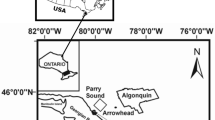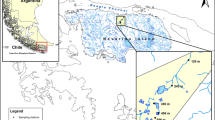Abstract
To better understand the impacts of water temperature variation on stream invertebrates, we sampled benthic assemblages and measured water temperature monthly in headwater streams located in northeast Japan during 2011 and 2012. The sites in headwater streams had similar hydraulic and topographical settings, were free of man-made structures, and ranged in elevation from 100 to 850 m above sea level. The results of month-by-month analysis on the relationship between temperature and Plecoptera density revealed that the abundance declined with highly elevated temperatures in mid-summer (July, August). The strongest relationship between variation in Plecoptera abundance (June to October in 2012), however, and water temperature occurred during early summer (June). Thus, early summer temperatures contribute to greater seasonal increase in abundance, suggesting that snapshot data may be unreliable for detecting consistent relationships between the abundance and temperature. The degree of similarity in benthic fauna between sites was significantly negatively correlated with differences in water temperature but not correlated with geographical distance. These results suggest that faunal composition varies along the water temperature gradient rather than habitat connectivity in temperate headwater streams.



Similar content being viewed by others
References
Bachman, R. A., 1984. Foraging behavior of free-ranging wild and hatchery brown trout in a stream. Transactions of the American Fisheries Society 113: 1–32.
Brielmann, H., C. Griebler, S. Schmidt, M. Rainer & T. Lueders, 2009. Effects of thermal energy discharge on shallow groundwater ecosystems. Federation of European Microbiological Societies Microbiology Ecology 68: 273–286.
Brittain, J. E., 1991. Effect of temperature on egg development in the Australian stonefly genus, Austrocercella lilies (Plecoptera: Notonemouridae). Australian Journal of Marine and Freshwater Research 42: 107–114.
Brunke, M. & T. Gonser, 1997. The ecological significance of exchange processes between rivers and groundwater. Freshwater Biology 37: 1–33.
Buisson, L. L., G. G. Blanc & G. Grenouillet, 2008. Modelling stream fish species distribution in a river network: the relative effects of temperature versus physical factors. Ecology of Freshwater Fish 17: 244–257.
Butryn, R. S., D. L. Parrish & D. M. Rizzo, 2013. Summer stream temperature metrics for predicting brook trout (Salvelinus fontinalis) distribution in streams. Hydrobiologia 703: 47–57.
Caissie, D., 2006. The thermal regime of rivers: a review. Freshwater Biology 51: 1389–1406.
Chang, H. & I. Jung, 2012. Spatial patterns of March and September streamflow trends in Pacific Northwest streams, 1958–2008. Geographical Analysis 44: 177–201.
Cummins, K. W., 1974. Structure and function of stream ecosystems. BioScience 24: 631–641.
Domisch, S., S. C. Jähnig & P. Haase, 2011. Climate-change winners and losers: stream macroinvertebrates of a submontane region in Central Europe. Freshwater Biology 56: 2009–2020.
Duggan, I., I. Boothroyd & D. Speirs, 2007. Factors affecting the distribution of stream macroinvertebrates in geothermal areas: Taupo Volcanic Zone, New Zealand. Hydrobiologia 592: 235–247.
Durance, I. & S. J. Ormerod, 2007. Climate change effects on upland stream macroinvertebrates over a 25-year period. Global Change Biology 13: 942–957.
Filipe, A. F., J. E. Lawrence & N. Bonada, 2013. Vulnerability of stream biota to climate change in mediterranean climate regions: a synthesis of ecological responses and conservation challenges. Hydrobiologia 719: 331–351.
Gaufin, A. R. & S. Hern, 1971. Laboratory studies on tolerance of aquatic insects to heated waters. Journal of the Kansas Entomological Society 44: 240–245.
Grimm, N. B., 1988. Role of macroinvertebrates in nitrogen dynamics of a desert stream. Ecology 69: 1884–1893.
Gunawardhana, L. N. & S. Kazama, 2012. Statistical and numerical analyses of the influence of climate variability on aquifer water levels and groundwater temperatures: the impacts of climate change on aquifer thermal. Global and Planetary Change 86–87: 66–78.
Haidekker, A. & D. Hering, 2008. Relationship between benthic insects (Ephemeroptera, Plecoptera, Coleoptera, Trichoptera) and temperature in small and medium-sized streams in Germany: a multivariate study. Aquatic Ecology 42: 463–481.
Hawkins, C. P., J. N. Hogue, L. M. Decker & J. W. Feminella, 1997. Channel morphology, water temperature, and assemblage structure of stream insects. Journal of the North American Benthological Society 16: 728–749.
Heino, J., 2001. Regional gradient analysis of freshwater biota: do similar biogeographic patterns exist among multiple taxonomic groups? Journal of Biogeography 28: 69–76.
Jacobsen, D., R. Schultz & A. Encalda, 1997. Structure and diversity of stream invertebrate assemblages: the influence of temperature with altitude and latitude. Freshwater Biology 38: 247–261.
Jacoby, J. M., 1987. Alterations in periphyton characteristics due to grazing in a Cascade foothill stream. Freshwater Biology 18: 495–508.
Karr, J. & D. Dudley, 1981. Ecological perspective on water quality goals. Environmental Management 5: 55–68.
Kawai, T., 2005. Aquatic Insects of Japan: Manual with Keys and Illustration. Tokai University Press, Tokyo. (in Japanese).
Kreutzweiser, D. P., S. S. Capell & S. B. Holmesa, 2009. Stream temperature responses to partial-harvest logging in riparian buffers of boreal mixedwood forest watersheds. Canadian Journal of Forest Research 39: 497–506.
Lang, C. & O. Reymond, 1995. An improved index of environmental quality for Swiss rivers based on benthic invertebrates. Aquatic Sciences 57: 172–180.
Meyer, J., M. Sale, P. Mulholland & N. Poff, 1999. Impacts of climate change on aquatic ecosystem functioning and health. Journal of the American Water Resources Association 35: 1373–1386.
Mielke, O. H. H., E. Carneiro & M. M. Casagrande, 2012. Hesperiidae (Lepidoptera, Hesperioidea) from Ponta Grossa, Paraná, Brazil: 70 years of records with special reference to faunal composition of Vila Velha State Park. Revista Brasileira de Entomologia 56: 59–66.
Moore, R. D. & S. M. Wondzell, 2005. Physical hydrology and the effects of forest harvesting in the Pacific Northwest: a review. Journal of the American Water Resources Association 41: 753–784.
Morrill, J. C., R. C. Bales & M. H. Conklin, 2005. Estimating stream temperature from air temperature: implications for future water quality. Journal of Environmental Engineering 131: 139–146.
Nukazawa, K., J. Shiraiwa & S. Kazama, 2011. Evaluations of seasonal habitat variations of freshwater fishes, fireflies, and frogs using a habitat suitability index model that includes river water temperature. Ecological Modelling 222: 3718–3726.
Parry, M., O. Canziani, J. Palutikof, P. V. Linden & C. Hanson, 2007. Climate Change 2007: Impacts, Adaptation and Vulnerability. Summary for Policymakers. Cambridge University Press, New York.
Pierce, R. J., 1986. Foraging responses of stilts (Himantopus spp.: Aves) to changes in behavior and abundance of riverbed prey. New Zealand Journal of Marine and Freshwater Research 20: 17–28.
Qu, R., X. Cui, H. Yan, E. Ma & J. Zhan, 2013. Impacts of Land Cover Change on the Near-Surface Temperature in the North China Plain. Advances in Meteorology (Article ID 409302).
Quinn, J. & C. Hickey, 1990. Characterisation and classification of benthic invertebrate communities in 88 New Zealand rivers in relation to environmental factors. New Zealand Journal of Marine and Freshwater Research 24: 387–409.
Quinn, J. & G. Steele, 1994. Upper thermal tolerances of twelve New Zealand stream invertebrate species. New Zealand Journal of Marine and Freshwater Research 28: 391–397.
Revenga, C., I. Campbell, R. Abell, P. Villiers & M. Bryer, 2005. Prospects for monitoring freshwater ecosystems towards the 2010 targets. Philosophical Transactions of The Royal Society B: Biological Sciences 360: 397–413.
Richardson, J. S. & R. J. Danehy, 2007. A synthesis of the ecology of headwater streams and their riparian zones in temperate forests. Forest Science 53: 131–147.
Ruesch, A. S., C. E. Torgersen, J. J. Lawler, J. D. Olden, E. E. Peterson, C. J. Volk & D. J. Lawrence, 2012. Projected climate-induced habitat loss for Salmonids in the John Day River Network, Oregon, U.S.A. Conservation Biology 26: 873–882.
Shannon, C. E., 1948. A mathematical theory of communication. Bell System Technical Journal 27: 379–423.
Smith, K., 1972. River water temperatures - an environmental review. Scottish Geographical Magazine 88: 211–220.
Sørensen, T., 1948. A method of establishing groups of equal amplitude in plant sociology based on similarity of species content. Biologiske Meddelser Kongelige Danske Viednskabernes Selskab 5: 1–34.
Statzner, B. & B. Higler, 1986. Stream hydraulics as a major determinant of benthic invertebrate zonation patterns. Freshwater Biology 16: 127–139.
Story, A., R. D. Moore & J. S. Macdonald, 2003. Stream temperatures in two shaded reaches below cut blocks and logging roads: downstream cooling linked to subsurface hydrology. Canadian Journal of Forest Research 33: 1383–1396.
Sweeney, B. W. & R. L. Vannote, 1986. Growth and production of a stream stonefly: influences of diet and temperature. Ecology 67: 1396–1410.
Taylor, C. A. & H. G. Stefan, 2009. Shallow groundwater temperature response to climate change and urbanization. Journal of Hydrology 375: 601–612.
Vannote, R. L., G. W. Minshall, K. W. Cummins, J. R. Sedell & C. E. Cushiong, 1980. The river continuum concept. Canadian Journal of Fisheries and Aquatic Sciences 37: 130–137.
Watanabe, K., S. Kazama, T. Omura & M. T. Monaghan, 2014. Adaptive genetic divergence along narrow environmental gradients in four stream insects. PLoS One 9: e93055.
Webb, B. W., D. M. Hannah, R. D. Moore, L. E. Brown & F. Nobilis, 2008. Recent advances in stream and river temperature research. Hydrological Processes 22: 902–918.
Wigington Jr, P. J., J. L. Ebersole, M. E. Colvin, S. G. Leibowrtz, B. Miller, B. Hansen, H. Lavigne, D. White, J. P. Baker, M. R. Church, J. R. Brooks, M. A. Cairns & J. E. Compton, 2006. Coho salmon dependence on intermittent streams. Frontiers in Ecology and the Environment 4: 513–518.
Acknowledgments
This research was partially supported by the Ministry of Education, Science, Sports, and Culture through a Grant-in-Aid for Scientific Research (A) (25241024, Yasuhiro Takemon, 2013–2016), Young Scientists (B) (26820196, Kei Nukazawa, 2014–2016) and Challenging Exploratory Research (26630247, Kozo Watanabe, 2014–2016) and the Japan Society for the Promotion of Science Research Fellowship (Grant #: 256493). Finally, we would like to thank the handling editor and anonymous reviewers for offering fruitful suggestions and comments.
Author information
Authors and Affiliations
Corresponding author
Additional information
Handling editor: Sonja Stendera
Electronic supplementary material
Below is the link to the electronic supplementary material.
Rights and permissions
About this article
Cite this article
Arai, R., Nukazawa, K., Kazama, S. et al. Variation in benthic invertebrate abundance along thermal gradients within headwater streams of a temperate basin in Japan. Hydrobiologia 762, 55–63 (2015). https://doi.org/10.1007/s10750-015-2336-8
Received:
Revised:
Accepted:
Published:
Issue Date:
DOI: https://doi.org/10.1007/s10750-015-2336-8




